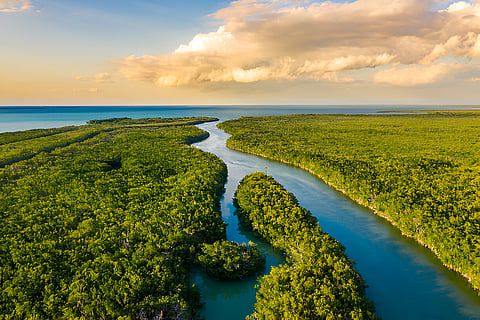Exploring The Enchanting Everglades: Encounter Seven Must-See Creatures In Florida’s Wild Oasis
Spanning 1.5 million acres across South Florida, the Everglades captivates visitors with its diverse wildlife. Boasting more than 2,000 species of plants and animals, including more than 70 threatened or endangered species, this unique ecosystem attracts nature lovers, birdwatchers, and adventure seekers alike.
Taking a closer look at the must-see animals in the Everglades isn’t just an opportunity to sample its richness and diversity – it is an opportunity to learn more about the unique efforts currently being made to restore the delicate balance of this remarkable ecosystem.
Did you know that the Everglades is the largest tropical wilderness in the United States?
1. Roseate Spoonbill

For a burst of color against the green backdrop of the Everglades, keep an eye out for the elegant Roseate Spoonbill. With its distinctive pink plumage and spoon-shaped bill, this wading bird is a sight to behold. Watch as they gracefully wade through the shallow waters, sweeping their bills from side to side in search of aquatic insects and small fish. Spoonbills, like most wading birds in the Everglades, have experienced a dramatic reduction in nesting. Restoring the freshwater flow through Everglades restoration will help support healthy wading bird populations in the Everglades.
2. American Alligator

No visit to the Everglades is complete without encountering the iconic American alligator, which can be spotted sunbathing along the water’s edge or gliding through the swamps. However, the American alligator is more than a perfect photo opportunity – it is also considered an “ecological indicator.” Because alligators are sensitive to hydrology and salinity, scientists can monitor their populations to see how they respond to environmental changes, including freshwater flow and water quality. Restoration work ensures that the ecosystem functions properly, with the alligator reflecting the progress of restoration as it responds to changes in the environment.
3. Anhinga

Known as the “snakebird” for its long, slender neck, the anhinga is a water bird commonly found in the Everglades. Its waterways provide an ideal environment for anhingas to thrive as they prefer shallow, slow-moving, sheltered waters for hunting with access to nearby perches and banks for drying and sunning themselves. If you visit Everglades National Park’s Anhinga Trail, you will surely catch them perched, drying their feathers after a dive!
4. Florida Panther

The Florida Panther is one of the Everglades' most elusive and endangered species. With its sleek coat and piercing eyes, this big cat roams the wilderness for prey. The once homogenous Everglades are fragmented, leaving less suitable habitat for panthers to roam and breed. While sightings are rare, the thrill of knowing these majestic creatures inhabit the same space adds an air of mystery to the Everglades experience. Constructing wildlife corridors unifies panther territory and helps the population flourish.
5. Florida Manatees

These massive marine mammals, characterized by their large, round bodies and paddle-like flippers, are beloved icons of the Everglades' aquatic ecosystem. Manatees graze on aquatic vegetation and can often be seen leisurely swimming or basking in the sun near freshwater springs, rivers, and coastal areas.
Manatees depend on healthy aquatic ecosystems with access to freshwater sources and abundant seagrass beds for feeding and shelter. Restoration of natural and freshwater springs is vital for providing essential warm-water refuges for manatees during the colder months.
These warm-water refuges play a crucial role in protecting manatees from cold stress-related illnesses and ensuring their survival during winter periods. Everglades restoration projects will reduce polluted water discharges into estuaries where the Florida Manatees thrive, reduce the likelihood of algal blooms, and thus improve habitats for these gentle sea cows.
6. Eastern Diamond-backed Rattlesnake

You may also encounter the Eastern diamond-back rattlesnake in the drier habitats of the Everglades. As the largest venomous snake in North America, this impressive reptile adds excitement to the region's diverse fauna. If you find yourself walking under large pine trees or in a hardwood hammock, you can envision rattlesnakes resting within palmetto thickets or gopher tortoise burrows. Whether walking on a nature trail or a suburban sidewalk, if seen, keep a respectful distance.
7. Great Blue Heron

The Great Blue Heron is a majestic sight in the Everglades, with its tall stature and graceful movements. These elegant birds are often seen wading through the shallow waters or standing statuesque along the marshy shores, patiently waiting to catch their next meal. With their striking blue-gray plumage and long, dagger-like bills, Great Blue Herons are unmistakable symbols of the Everglades' avian diversity.
Ongoing restoration efforts focus on improving water quality and restoring natural hydrological patterns, which are essential for sustaining the diverse food web upon which the Great Blue Heron depends. By ensuring adequate freshwater flow and reducing pollutants, restoration initiatives help maintain the health of fish populations – the primary food source of Great Blue Herons – to provide an abundant food source for these magnificent birds.
With its diverse flora and fauna, the Everglades offers much to visitors and scientists alike. However, the size of this wetland preserve has decreased, which puts pressure on the habitat quality of the remaining Everglades. By learning about and supporting restoration efforts, we can ensure that this ecosystem is restored and remains protected so it can provide maximum benefits to inhabitants, to visitors, and to all the places that depend on freshwater from the Everglades.
For more information about supporting The Everglades Foundation, please visit evergladesfoundation.org/giving.
Become an Insider! Step into the world of luxury with RESIDENT Magazine. Click here to subscribe to our exclusive newsletter and gain unparalleled access to the latest in luxury lifestyle, high-end real estate, travel exclusives, and so much more.
Are you interested in advertising with Resident? Email us at advertising@resident.com to learn more.



